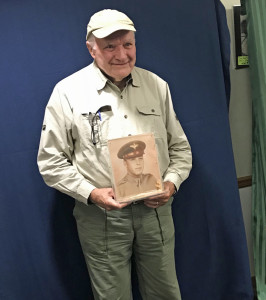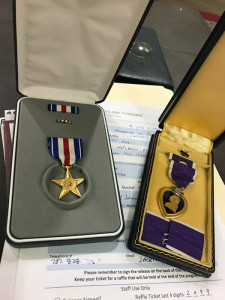True Tales from Canton’s Past: Military Portraits
By George T. ComeauThey were the daughters, the brothers, the parents, and the soldiers themselves. They came to share their stories. Some neighbors shared heroic tales, and others told of sadness and loss. And in the voices of these people was pride and patriotism. The ideals of our nation lay bare in their hands. They carried brittle yellow photographs, news clippings, obituaries, and even a Purple Heart and Silver Star. They all came to share, and we came to listen and learn.

Doug Wood shares a photo of his brother who was killed in a flight training accident in Lubbock, Texas in 1942.
Several months ago our library director, Mark Lague, along with Carolyn Elkort and Lisa Quinn began discussing how the Canton Public Library could engage the community in an active way that would bring stories and memories to a greater audience. Elkort suggested that the library could work with veterans and their families to scan photographs and collect their stories. It seemed like a fairly straightforward way to reach out to the community and perhaps crowd source local history.
The response was, needless to say, successful. The Community Room was set with several intake tables. Special forms had been created to capture the meta-data that would accompany the photographs and materials. Volunteers met in a quiet environment as the families and friends gathered to share their stories. And words will never capture the flood of emotions from the men and women who stepped forward to help Canton remember.
I sat across from Doug Wood, who had brought along a photograph of his brother Andrew. That was all he carried, an 8×10-inch military portrait of Andrew. I leaned in to hear his story. “I was 9 years old when Andrew died,” explained Doug. Andrew Ross Wood had been born in Aberdeen, Scotland, in 1918. The family came to the United States in 1922 and eventually moved to Canton to live on Indian Lane near their mother’s relatives. “They had a very rural house on several acres of land in the woods, and lacked running water or electricity.” Doug told the story as if it were yesterday. After two years at the Burdett Business School, Andrew enlisted in the Air Corps as an aviation cadet. That was on February 6, 1942.
On, August 26, 1942, just about 200 days after Andrew had enlisted — and only 22 days after he entered the final phases of air training school — he climbed into the cockpit of a Curtis-Wright AT-9 training bomber. It is hard to comprehend, but on that same day there were 49 military aircraft accidents across the United States, many involving fatalities during training. The story is indeed heroic. Flying in a 15-plane formation, the plane in front of Andrew hit an air pocket and dropped. Upon regaining altitude the two planes collided in mid air. The pilot next to Andrew ejected and lived. Andrew stayed behind and steered the plane into the ground in a field away from civilians and was killed instantly.
The story is so sad. A life ended before it really began. And here was Andrew’s brother sharing his sadness more than 75 years later. What his brother remembers is vivid. Andrew was a star football player at Canton High School, and in Doug’s eyes larger than life. “I visited his grave at Canton Corner today,” he quietly shared.
At the very next table, David Crowley sat with a small pile of photographs. David held a late 19th century cabinet card photo in his hand of his great uncle Timothy J. Crowley. Crowley smiled with pride as he shared his family story that was sparked by the tale of a violin that dates back to 1865 and is still in the family. Timothy Crowley was born in Ireland and lived in Ponkapoag; he served as the town’s tree warden and was active in civic life. The photograph shows an elder distinguished gentleman sitting for his portrait in Omaha, Nebraska.
The great nephew smiled, simply because the genealogical research is a fantastic puzzle that he has worked on for many years. Crowley explained that his ancestor had been a private in the 7th Calvary, Company H as well as in the 2nd Infantry Army from Massachusetts. The movement from Omaha ultimately to Washington, D.C., is still part of the Crowley family research. Most wonderful is the fact that when this soldier died in 1923, he was buried at Arlington National Cemetery. The violin is part of a much longer story.
But perhaps the most poignant moment came when a quiet couple came to the table with two small blue boxes. The photo that accompanied the boxes was in a worn leather folio. Inside was an official military portrait of Frederick Wilson Powers. His son sat back to tell the story. “I was not yet 4 years old when my dad went off to war,” he said.

The Purple Heart and Silver Star awarded to Frederick Wilson Powers who was killed in Heilbronn, Germany, in 1945.
Jack Powers spoke clearly, yet never really knew his father. Born on July 4, 1918, Powers was enlisted on June 9, 1943, as an infantryman in the 100th Division, 397th Regiment, Company G. “My father was a scout that was sent out to look for a machine gun nest full of Germans,” explained Powers. The patrol had been cut off from the platoon and Powers was mortally injured in the process. Refusing evacuation, he died on April 4, 1945.
There is a second photo that Powers brought to the library. It is a small black and white snapshot that had been included in the personal effects returned to the family soon after the soldier died. Looking closely, the years dissolve and it’s easy to see the battlefield aftermath and a Catholic chaplain presenting last rights over the dead soldier. That is the last image of Frederick Powers, at rest in death on a field in Heilbronn, Germany, so very far from home. The family holds that photo in their hearts forever. After Powers was killed he was buried — three times to be exact. First he was buried in Germany, and then again in France. In 1947 the U.S. government offered the families in the United States the opportunity to have their loved ones exhumed and sent home.
A train brought PFC Powers back to Canton Junction. With a ceremonial escort, the fallen soldier was brought to 371 Washington Street — the same home that his son still lives in. The casket was positioned in the front room, and friends and neighbors came to comfort the widow. Almost three years had passed, and that boy who hardly could comprehend the loss was witness to the aftermath. The military funeral followed with burial at St. Mary’s.
And finally there were also joyful stories. Al Nordgren told of his brush with death in Vietnam. “I had been flying on the last day I was to leave for home,” he recalled. “It was against the rules; you never flew the week prior to a departure stateside. I landed at 1 a.m. and had to decide to take a shower or read a book in my barracks. I took a shower. Literally within moments of showering I immediately heard two dull thuds. I rushed, barely wrapped in a towel to the fallout area. The sound was my very own barracks being bombed. When I returned from the fallout bunker all that remained was my destroyed suitcase.” It was a true old-fashioned war story with a good ending. I smiled, and Al looked to me and asked me the moral of the story, to which he quickly answered, “Cleanliness is next to Godliness.”
Short URL: https://www.thecantoncitizen.com/?p=37398










